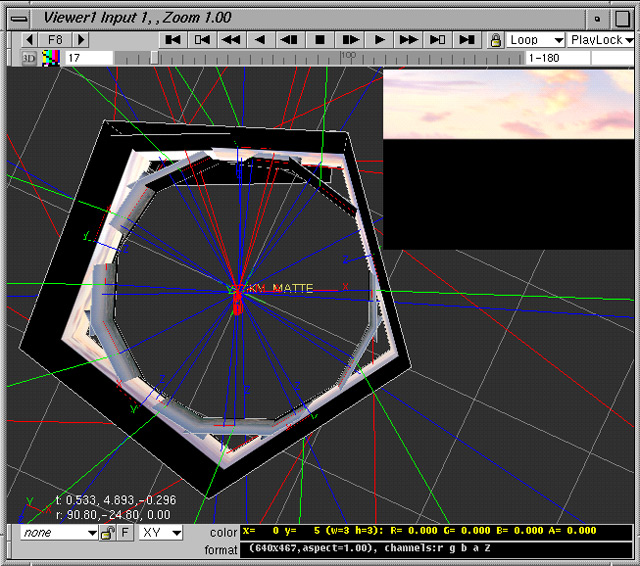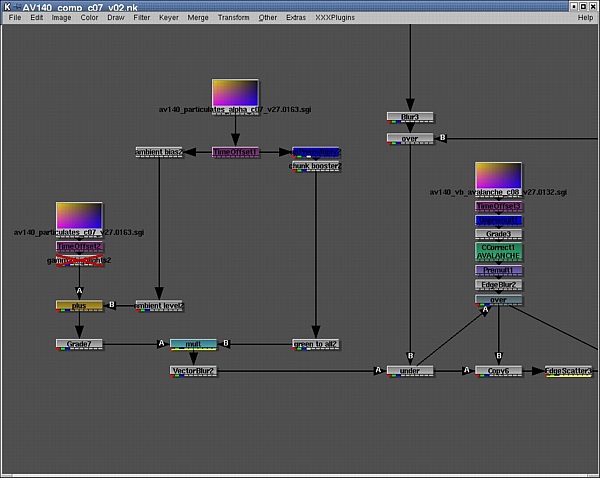Digital Domain’s in house compositing software has been the subject of speculation recently – will it become a product to step in and fill the gaps created by recent aquisitions? We sat down for the facts with Michael Taylor, Digital Domain’s Vice President of Digital Production and Technology…
In the world of node based compositing we have seen quite a few software
packages undergo major changes or disappear altogether over the last few
years. Programs like Cineon and Illusion just went away, projects
cancelled by their owners (and big owners they were – Kodak and Avid).
Recently Apple bought Shake and Rayz and changed their focus to be Mac
platform only, and surely part of a larger plan. This leaves a large
installed user base and only C2 and DF as the only real NT/W2K
compositing options in this price range. Node based compositing has found it’s strongest hold in feature film work where producing iterations of shots may be
more important than providing client level interactivity. A majority of
3D people made the transition over the last few years from sgi to
Intel and they also need these types of compositing tools.
When Digital Domain started in 1993 they became one of Discreet’s
largest customers and at the same time they began to write their own
in-house compositing package called Nuke. There has been speculation on
the various web forums lately about Nuke becoming a product, so we went
to the source, speaking with Michael Taylor, Digital Domain’s
Vice President of Digital Production and Technology – one of his
responsibilites is proprietary software development..

Michael Taylor
Tell us a bit about Nuke:
Nuke is our in-house 2D compositing tool, used every day in production.
Nuke operates in full floating point and supports such technologies as
HDR and up to 32 channels per image (z depth, alpha – whatever) – it
also has a full 3D architecture with support for cameras and strong
plug-in capabilities. Last year we rolled out version 3.0 with a
redesigned architecture. We are very proud that Nuke won a Technical
Achievement Oscar last year.
(fxguide note – from the Oscar Web Site:
Technical Achievement Award to Bill Spitzak, Paul Van Camp, Jonathan
Egstad and Price Pethel for their pioneering effort on the NUKE-2D
Compositing Software)

screenshot of 3D view in Nuke
So what about these rumours that DD is considering spinning out Nuke
as a product?
We have thought about that over the years and as people have moved on
from DD we have heard that they wish they had Nuke at their new jobs.
Recent changes in the marketplace combined with some serious inquiries
have us considering it. We would appreciate hearing from fxguide users
if Nuke being available is something that would interest them.
(fxguide note – later in this article there is and email address for feedback direct to DD, also see the poll attached to this article and use the comments area below this article)

screenshot of a sample script in Nuke, click image to see larger
How would you see Nuke as a product?
I would say the paradigm would be similar to that of Renderman. A tool
that is in use daily in a very large, busy facility that we then make
available to the community. We don’t see it as a huge shrink-wrap
business, rather a way to fund future development of Nuke and fill a void created by recent developments. We would be unique in this market – developers who also use the product in production. We’d probably setup a separate entity to market and support it, pricing would be comparable to the current version of Shake with different option levels.
What platform(s) does Nuke run on:
It operates on Linux, Windows and Irix for both the interactive and non-interactive Environment.
I recall when Nuke first started there was talk that it could read
Discreet action setup files and render them using Nuke’s scanline
renderer – is that still a part of Nuke and would it be part of a
commercial version?
It has always been a part of Nuke and again, we use this daily. Not
sure if this would be part of any commercial version but that would be a powerful option to offer.
Any other tools you are considering?
We have a host of in-house tools in addition to Nuke… tools developed
in response to our production needs. For example we have an award
winning 3D tracking solution. Right now they are still in-house tools,
but if we do this and there is demand, you never know…
So the message is “We are considering doing this, let us know if you
would be interested”?:
Yes. People can contact us at [email protected]. We’ll also
check back here to see comments and the poll results.
UPDATE: July 12th – The Hollywood Reporter has a story that Scott Ross will announce his intention to market Nuke at Siggraph. Here is a link to the story
fxguide note:
Also check out the coffee table book “Digital Domain: The Leading Edge of Visual Effects“. This is a great quality book filled with illustrations and shot breakdowns.
Here is a blurb from the Amazon review:
Readers will discover dozens of cutting-edge special effects techniques, ranging from model-making and CGI morphing to digitally created virtual sets and “synthespians.” Unique, frame-by-frame deconstructions demonstrate how the most sophisticated special effects are achieved, and stunning case examples from the company’s work illustrate basic effects from conception to completed sequences.
Plus, dozens of previously unpublished, behind-the-scenes photos reveal the expert artistry needed to create these groundbreaking effects, as well as the various ways digital imaging is combined with the work of set designers, model makers, and production artists to achieve brilliant results.
Digital Domain also includes an interesting overview of the future of movie technology—including the almost certain elimination of film stock—as well as the recent blurring between the traditional “cinema” experience and the growing new market for theme park rides and PC game simulators.
